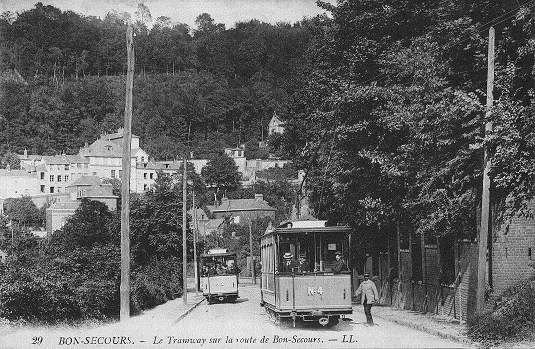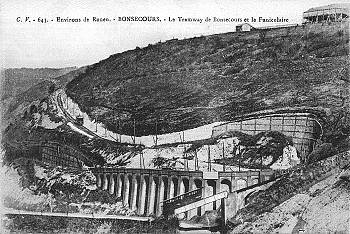

Our main postcard shows cars 2 and 4 of the Compagnie des Tramways de Bonsecours-les-Rouen. The view was taken around 1905 at the on-street passing loop at Grâce de Dieu. The card was published by that most famous of French card producers, Lévy Fils et Cie, of 44 Rue Letellier, Paris, and is no. 29 in their Rouen series. The smaller view below, dating from the same period, is taken from card 643 of a local publisher whose initials were C.V. and shows both the tramway and the funicular.
The Bonsecours tramway of the Compagnie des Tramways de Bonsecours-les-Rouen was created as a private standard gauge line, quite separate from the main tramways of Rouen. It ran a distance of about 3.5 miles (5.629 km) on the right bank of the River Seine from the Pont Corneille (Pont de Pierre) in Rouen, climbing 487 feet to the village of Bonsecours and where there is a Basilica and monument to Joan of Arc (who was tried and executed in Rouen in 1431), a popular target for pilgrims and tourist traffic.
The tramway was created by M. Armand Requier, a local man who had for many years wanted to see Rouen connected to the commune of Blosseville Bonsecours, where he owned a brickworks, and who in 1889 had considered a narrow gauge steam railway. His son, Marcel, was an engineer in America with Westinghouse of Pittsburgh. Influenced by Marcel to switch to electricity using Westinghouse's products, Requier senior obtained authorisation on 7th March 1894, the first tram running on 22nd April 1899 and the tramway officially opening on 21st May with Armand Requier driving the first car. The tramway had cost some 1,100,000 Francs to build (including rolling stock).
The route commenced at Pont Corneille and followed Quai de Paris and the Route Nationale 14 that went to Bonsecours through Eauplet. At the valley of Grâce de Dieu, it branched off onto its own private right of way on sleeper track. This contained a 180 degree deviation (see small view), at a radius in parts of 66 feet, and a very deep cutting with retaining walls and viaduct used to gain height without very steep gradients, the greatest being 1 in 12.5 for a distance of 39 feet, a slope named La Cavée. Beyond this point the tramway passed the Bonsecours funicular railway, curving past the ancient fort of Thuringe. Rejoining Route Nationale 14 at the upper part of the Grâce de Dieu valley, it passed through Bonsecours village and the wooded area called Plateau des Aigles, terminating in the commune of Mesnil-Esnard at the cross-roads with the Belboeuf road.
 The funicular mentioned above was built by engineers Ludwig and Schopfer of Berne, and was Swiss owned. It opened on 19th June 1892 and connected the riverside at Eauplet on Route Nationale 182, where water buses called at a pier, with the Bonsecours Basilica. Built to 1.2 metre gauge, it also had a Riggenbach rack rail used for braking. It was 403 metres long and climbed 132 metres at a maximum gradient of 36 percent. The two cars each carried 90 passengers, 50 seated, and they were worked by water counterbalance. As there was no water on the plateau, it was pumped from the Seine, at first by steam and then after 1910 by electricity. In 1894 the funicular company had also considered an electric tramway to Rouen, but this was not followed up. In 1898 it had carried 207,249 passengers, but this fell off badly to 132,464 in 1902 after the Bonsecours tramway opened. Soon getting into financial trouble, operation was taken over by the Bonsecours tramway on 25th November 1905, but this was not legally finalised until 1910. The funicular closed on 15th May 1915.
The funicular mentioned above was built by engineers Ludwig and Schopfer of Berne, and was Swiss owned. It opened on 19th June 1892 and connected the riverside at Eauplet on Route Nationale 182, where water buses called at a pier, with the Bonsecours Basilica. Built to 1.2 metre gauge, it also had a Riggenbach rack rail used for braking. It was 403 metres long and climbed 132 metres at a maximum gradient of 36 percent. The two cars each carried 90 passengers, 50 seated, and they were worked by water counterbalance. As there was no water on the plateau, it was pumped from the Seine, at first by steam and then after 1910 by electricity. In 1894 the funicular company had also considered an electric tramway to Rouen, but this was not followed up. In 1898 it had carried 207,249 passengers, but this fell off badly to 132,464 in 1902 after the Bonsecours tramway opened. Soon getting into financial trouble, operation was taken over by the Bonsecours tramway on 25th November 1905, but this was not legally finalised until 1910. The funicular closed on 15th May 1915.
The standard gauge track of the Bonsecours tramway was mostly single with 1,650 feet long passing loops. As well as at the termini and the depot, originally these loops were at Quai de Paris opposite Boulevard Gambetta, at the road fork at Eauplet, at Grâce de Dieu before starting the private track and at the Plateau des Aigles. Other loops were added later towards Mesnil-Esnard and at the lower exit of the large curved section. Street track was laid in 38 kg per metre Broca grooved rail. The reserved track was in flat bottom rail at 25 kg per metre laid on wooden sleepers. An extension to Boos, which would have doubled the length of the tramway, was authorised but never built.
There were fare stages at Eauplet, Grâce de Dieu and Bonsecours with a fare of 15 centimes first class and 10 centimes second class per stage, with fares for the whole tramway of 50 centimes and 40 centimes respectively. The run from end to end took about half an hour. By 1901 passenger numbers had risen to 688,866 and by 1911 to 834,060, with trams every 15 minutes in summer and 30 minutes in winter.
Located in the middle of the line at Bonsecours, was the power station and depot. There were two Babcock and Wilcox multi-tube boilers with a heating surface of 1,830 square feet and working at a pressure of 177 p.s.i. The power station chimney was just under 150 feet high and 6 feet in diameter, There were two condensing engines each of 200 horsepower working at 200 r.p.m. and having a 16.3 feet diameter 16 ton flywheel. There was belt drive to two Westinghouse 150 kilowatt dynamos generating 560 volts D.C. There were feeders to each half of the tramway's overhead. Towards Rouen double overhead was used but in the direction of Mesnil-Esnard it was single. The overhead used both span wires and bracket arms carrying the 3/8 in. diameter wire at a height of 21ft. 3in. above the centre of the track. As water was short on the Bonsecours plateau, large reservoirs were built to collect rain water and the condensate from the engines was returned to these. The depot was built of wood and had three roads, with a triangular junction to the main line.
The trams were built in the Paris area but were mounted on American Peckham Cantilever 4-wheel trucks purchased via R.W.Blackwell and Company Ltd. of London. The trams were 2.2 metres wide, had first and second class compartments and seated 28 passengers plus an additional 20 standees on the platforms. There were originally 6 motor cars (1-6) with four side windows and two entrances (No. 7 with six windows was added in 1903). Each motor car had two 35 horsepower Westinghouse No.49 motors and Westinghouse 28A controllers. They were fitted with Dickinson swivel head trolleys. Hand braking was used, emergency electrical braking only being available by reversing the controller key. At one stage they had large advertisement panels fitted to their clerestory roofs. Instead of the usual gong, the cars used a piston operated horn. There were six similar but little used trailers (8-13) which carried 42 passengers, and since they were only for the summer, initially had no side window glazing, although some were later glazed. There was also a goods van (14). The fleet livery was blue and cream.
On 18th December 1909 the Bonsecours tramway was taken over by the Compagnie des Tramways de Rouen (CTR), who operated the main routes in the city, the line becoming their route 19. Economies in staffing were made and the depot and generating station were closed. In the next few years the CTR made some changes to the trams. The Peckham trucks were replaced by Brill 21E trucks with more powerful motors and rheostatic brakes. The couplings and the Dickinson trolleys were replaced by CTR standard ones. The trailer cars were transferred to the city system, although they could only be used on the Quevilly line due to their wide loading gauge. The motor trams were painted in CTR white and buttercup livery and were renumbered 94 - 100. The platform entrances were increased to four and after 1922 they were fitted with vestibules. Most of the track was relaid by CTR in 44 kg per metre Broca rail, with 54 kg per metre rail on some curves.
The Bonsecours tramway survived both world wars and finally closed on 24th February 1953, just four days before the last traditional trams ran in the city. Rouen opened a brand new tramway in 1994, but alas not on the scenic route to Bonsecours.
![]() Go to Postcard Of The Month Index
Go to Postcard Of The Month Index